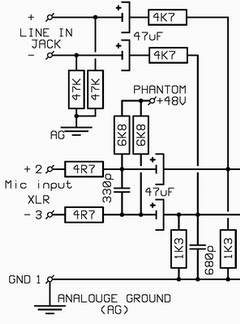> Here it is - for now only the analouge sections including the converters.
Great drawing, Jakob. Thanks.
As Joe says, it seems mighty likely that there are some series resistors on the line-in. As it stands, the gain is high and the input impedance is very low. Say what you like about B-co, they don't make inputs THAT odd.
The mike-amp bias looks wrong to me. Unless B-co is more clever than I am tonight, the 825R resistors (and diodes) must go to -15, not ground. (Or else the Bases are biased-up somewhat... I can't picture that just yet.)
With those corrections: it isn't sexy and it isn't best-possible performance, but I don't see where it sucks. The cascade transistors do give a pretty good mike-amp. They get the signal above the noise of the TLO74. The TL074 however does strain with that attenuation network hanging off its butt. A beefier amp might improve sound at the highest levels, or you could just not push it to the maximum.
I like Joe's suggested LM837. I'm not sure the noise matters, but the output is a lot beefier, and like 5534 they were designed to be audio-aware.
If you go Joe's full mod, losing the transistors, then a low-noise like LM837 is wanted.
> how would you limit the input signals to avoid killing the chip?
In this case, or any similar case, the 1K1 and 470 resistors pad-down the +/-13V swings to 2.3V swings at the ADC pins. No danger.
> drive the differential inputs on the converter directly with an input transformer - bypassing ALL the A/D analouge parts..
I did some calcs on a similar case, and I think to get the very-low impedance that the ADC pins need (to absorb their switching glitches) you wind up with a very low primary impedance. Something like 3K:100Ω Most gear will drive that, but.... And part of the idea IS to absorb switching spikes, which an audio transformer won't do well because of leakage inductance. So you might rather go 600Ω:20Ω with a good 20Ω resistor on the secondary, solid 600Ω impedance on the primary, which for some popular-price boxes (can you spell TL072?) is a Heavy Load.
Metering could be extended, but this simple thing tells you what you need to know: you are using 23 of the 24 bits (Clip) and you are using at least 17 bits (-40dB). On music, watching the "-40" light will tell if you are getting more than just 17 bits (light is mostly-on, you are using around 20 bits). I mean, golly, this thing claims 144dB dynamic range!!! I know this aint true, that the bottom bits are all noise and the top-bit may be TL074 strain, but that still leaves a big target. I thought 24-bit was supposed to FREE us from meter-slavery, why meter?
If you already have lovely mike-amps (or live at line level), and do NOT need gain control, then cut the wires from front to back board and put a couple 4K7 in front of the op-amp with two 3K9 resistors for a diff-input.


































